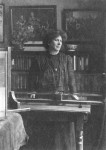- Painting of Hertha Ayrton, the scientist and inventor, by Mme. Darmesteter, 1909
- Mrs. Ayrton in her laboratory, Jewish Women’s Archive
by Gina Luria Walker
Phoebe Sarah Mark/Hertha Ayrton (1854-1923) transformed herself into Hertha Ayrton despite opposition to her sex, religion, poverty, inferior education, and poor health from the male culture of modern Physics. Born to a struggling Jewish watchmaker from Poland and his wife in Portsea, Portsmouth, Sarah quickly gave evidence of unusual intelligence. Her mother was pregnant with their eighth child when her husband died, leaving Mrs. Marks to support the family by her needlework. In 1863 Sarah’s aunt, writer Marion Hartog, invited Sarah to attend the school for young children she ran with her husband in London. Mrs. Marks encouraged her daughter to accept: she believed women needed more education than men to prepare them for the hardships they would encounter. In London, Sarah grew up with her talented cousins: the boys attended Cambridge University and distinguished themselves in Mathematics and Science; one of the girls became a portrait painter, another a composer and pianist. At sixteen Sarah went to work as a governess, sending money home to support her mother and siblings.
Sarah wanted to continue her education. She met intellectuals, radicals, and exiles in the Hartogs’ circle. Her friend Ottilie Blind dubbed Sarah ‘Hertha’ after the heroine of a novel by feminist Frederika Bremer who describes the struggles of her ‘soul which seeks freedom, life, and happiness for herself and her many sisters’. Ottilie introduced ‘Hertha’ to Barbara Bodichon, a leader of the Suffrage movement, and co-founder with Emily Davies of Girton College at Cambridge, a fledgling program for a small group of non-degree women students. Bodichon provided the funds for Herta to be tutored for the entrance examinations the university required for females. Bodichon and her friend George Eliot helped finance Hertha’s tuition at Girton after she passed the entrance tests with honors. Eliot is thought to have given the Jewish character of Mirah some of Sarah’s personal characteristics in her novel Daniel Deronda.
Hertha was admitted to Girton where she organized the college’s Fire Brigade, and sang in the Choral Society. Hertha, a classmate said, was “always the most striking figure among the students.” While at Girton, Hertha began her career as an inventor: she constructed a sphygmograph, a device for recording the pulse in arteries. Bodichon and Lady Goldsmid, another Girton supporter, paid for the patent. But Hertha barely passed the final examination in Greek and Latin required of Girton students. Hertha wrote to Bodichon, “I think it is very hard on you after all you have done for me, that I should do no better. It is not for want of work, nor even entirely of brains, but rather a want of memory and still more presence of mind in the exam room. So I have turned out a failure.”
She persisted. After receiving a certificate from Girton, Hertha supported herself by teaching. She began evening classes at the newly established Finsbury Technical College where she studied Physics under Professor William Ayrton, an electrical engineer, a leader in practical education, and a fellow of the Royal Society. William was a widower with a young daughter. He and Hertha married in 1885. William was Hertha’s most constant supporter. He commented to her cousin, Dr. Philip Hartog, “You and I are able people, but Hertha is a genius.” Hertha gave birth to a daughter in 1886 and named her ‘Barbara Bodichon Ayrton’ in honor of her benefactress. Hertha carried on her new responsibilities as wife and mother, assisted William with his experiments, and continued her own scientific interests. She was helped again by Barbara Bodichon who, at her death in 1891, left a legacy that Hertha used to hire a housekeeper. Now she pursued her research vigorously. She discovered ways to remedy the hissing noise and flickering illumination of the arc lamps that were widely used as street lights. Her work on arc lights was published in The Electrician in 1895 and The Electric Arc in 1902.
In 1899 Hertha became the first woman invited to read a paper at The Institution of Electrical Engineers, to be elected a member, and to receive a prize. Several London journalists attended her lecture. One reporter described her as “a little dark-haired, dark-eyed lady, wearing pince-nez, who created a sensation which perhaps accounted in some degree for the unusually large attendance of young men members.” The Spectator questioned if women ‘have a distinct proclivity towards science and mathematics, finding them less exhausting than either history or classics’. Another assured his readers that although a scientist, Hertha was not ’odd’ but ‘charming,’ and ‘in every way a woman’.
In 1902 she was nominated as a fellow of the Royal Society, but was rejected; her public advocacy of women’s issues had antagonized the president. The organization ruled, ‘married women are not eligible as Fellows of the Royal Society. Whether the Charters admit of the election of unmarried women appears to us to be very doubtful’. Hertha was awarded the Royal Society’s Hughes Medal for original discovery in 1906 while the President was inactive.
William Ayrton died in 1908. In 1915 Hertha presented the War Office with an anti-gas fan she invented that could blow enemy poison gas out of trenches. The administrators refused to take notice because as a woman her research was considered unreliable. But after the outbreak of World War I, more than 100,000 ‘Ayrton fans’ were used at the Front for the protection of British troops. Hertha then devised a method to improve searchlights; her technology was used in aircraft detection in both World Wars.
Hertha supported other women. She met physicist Marie Curie in 1903 in London when Pierre Curie was invited to a lecture at the Royal Society, after the Curies won the Nobel Prize for Physics. Both women attended as their husbands’ wives, not as scientists. After Pierre Curie’s death in 1906, Marie Curie was depressed and sick; she became the focus of public gossip over her relationship with another French scientist. Hertha gave Marie and her daughter secret sanctuary in England during the summer of 1912. In their correspondence, the two women exchanged anecdotes about being accused of riding on their husband’s scientific coat tails. Hertha wrote Marie, ‘An error that ascribes to a man what was actually the work of a woman has more lives than a cat’.
Hertha was close to her stepdaughter Edith and daughter who shared her feminist convictions. In 1945 Barbara Bodichon Ayrton, under her married name Gould, was elected to Parliament as an MP for the Labour Party. After Hertha’s death in 1923, Ottilie Blind Hancock established the Hertha Ayrton Fellowship at Girton College.
Hertha Ayrton was the only woman to experiment in electromagnetism since Italian Laura Bassi in the 1730s. In an article commemorating Women’s History Month in March 2010, a British journalist lamented that despite Hertha Ayrton’s remarkable contributions, she remains ‘largely forgotten’.
Video by Gina Luria Walker and Kaitlin Sansoucie.
Sources:
1895-1923. Mrs. Ayrton. Reminiscences written by A. P. Trotter, President of The Institution of Electrical Engineers (London).
American Jewish Year Book. A List of Events in 5672 and Necrology July 1, 1911, to June 30, 1912.
Biographies. A List of One Hundred Chosen by the Carnegie Library of Pittsburg. The New York Times. February 8, 1902.
Ely, Lynda M. “Not a Song to Sell”: Re-Presenting A. Mary F. Robinson. Victorian Poetry. Vol. 38, No. 1, Women Writers 1890-1918 (Spring, 2000), pp. 94-108.
Review: Fara, Patricia. “Out of the Shadows: Contributions of Twentieth-Century Women to Physics.” Edited by Nina Byers and Gary Williams. Nature: International Weekly Journal of Science. Nature 444, 548 (30 November 2006).
For Women In Science. http://www.womeninscience.co.uk
Review: Frenkel, Karen A. “Why Aren’t More Women Physicists?” Scientific American Magazine. February 2007.
Galchinsky, Michael. “Marion Hartog.” Jewish Women: A Comprehensive Historical Encyclopedia. 1 March 2009. Jewish Women’s Archive.
Girton College University of Cambridge.
Hatzfeld, Adolphe & Arsène Darmesteter. 1890-1900. Dictionnaire général de la langue française du commencement du XVIIe siècle jusqu’à nos jours, précédé d’un traité de la formation de la langue. With contributions by Antoine Thomas. (Paris: Ch. Delagrave).
Hirsch, Pam. “Hertha Ayrton.” Jewish Women: A Comprehensive Historical Encyclopedia. 1 March 2009. Jewish Women’s Archive.
Jacobs, Joseph and Goodman Lipkind. Jewish Encyclopedia.
Kowalski, Ania and Madzia. Sex and Science: A Cambridge Perspective. The Triple Helix, Inc. Cambridge 800th Anniversary Edition.
NNDB http://www.nndb.com
Ogilvie, M.B. “Marital Collaboration: An Approach to Science.” 1987. Uneasy Careers and Intimate Lives: Women in Science, 1789-1979, P.G. Abir-Am and D. Outram, eds. (Rutgers University Press, New Brunswick, NJ), 104–125.
Personal Papers of Barbara Leigh Smith Bodichon. Moore Family Papers.
Petersen, Julia K. Fiber Optics Illustrated Dictionary. CRC Press, 2003.
Proceedings of the IEEE. Volume 88, Issue 10 (Oct. 2000), 1677-1679.
Quinn, Susan. Marie Curie: A Life. (Da Capo Press, 1996), 337.
Scribd.com Marie Curie.
Singer, Isadore, Mary Robinson, Darmesteter Duclaux. Jewish Encyclopedia.com
Singer, Isadore and P.J. Hartog. Jewish Encyclopeida.com.
Tattersall, James J. and Shawnee L. McMurran. “Hertha Ayrton: A Persistent Experimenter.” Journal of Women’s History. Volume 7, Number 2 (Summer 1995), 86-112.
The Institution of Engineering and Technology. Archives Biographies: Hertha Ayrton.
The Panasonic Trust http://www.panasonictrust.net/fellowships/ayrton_awardees.aspx
Uglow, Jennifer S. and Maggy Hendry. The Northeastern Dictionary of Women’s Biography (UPNE, 1999), 38.
Victorian Literature and Culture (2006), 34:2:591-618 (Cambridge University Press. 2006).
Watts, Ruth, review of Femininity, Mathematics and Science, 1880-1914, (review no. 914).
Women’s History Month: “Hertha Ayrton (1854-1923): Scientist yet ‘in every way a woman’.” Women’s History Network Blog.
Tags: Europe, Industrial Revolution, Scientists


